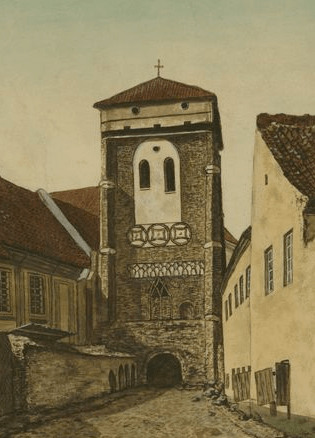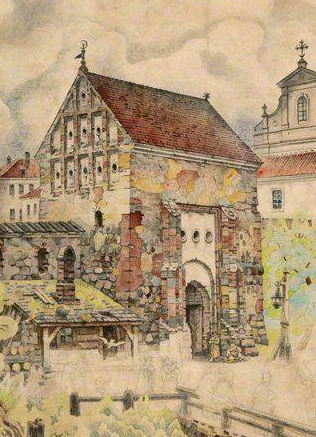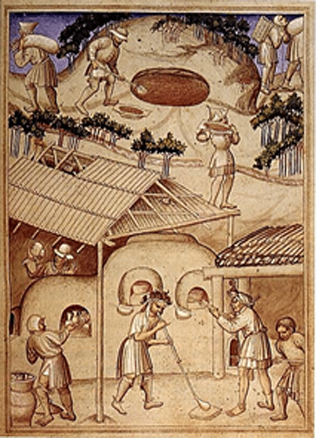Landscape of the Grand Duchy of Lithuania: Forests, Marshes and Lakes
A large part of the uninhabited territory of the Grand Duchy of Lithuania was covered by forests, marshes and lakes referred to as wilderness in historical sources. Foreign envoys travelling across the GDL referred to wildernesses in their accounts. A Burgundian knight Guillebert de Lanoy noted in the first half of the 15th century that after leaving Vilnius he had travelled through territories full of forests, marshes and lakes with few settlements. Sigismund von Herberstein, an envoy of the Holy Roman Empire, had similar impressions about the country in the 16th century because he saw plenty of marshes and forests on his way from Vilnius to Polotsk in winter. Travelling between Polotsk and Moscow, uninhabited territories and wildernesses were almost everywhere around him. For a long time, Western Europeans considered the GDL to be the country of forests and marshes.
Thick forests help hide from enemies
Small population of the GDL is an indication that its territory included many uninhabited lands. Population density was just three to four people per one square kilometre in Lithuanian lands in the 13th and 14th centuries. The number of inhabitants began growing later. Wildernesses separated sparse settlements and limited communication between people. Very often, they could only guess that other people lived across the surrounding forests and marshes. The 14th century descriptions by the German Order of roads leading to Samogitia and Lithuania very rarely mention local roads between settlements. People led sedentary and insular lives. In addition to limiting human interaction, natural obstacles served as defences against enemies.
Almost impenetrable forests and dangerous marshes guarded Lithuanian lands from sudden raids of the knights of the German Order.
The 14th century sources of the German Order say that anyone wishing to reach Lithuanian settlements must first clear the road, cut down trees, and build bridges across rivers and marshes. In certain instances, the knights would mark military routes in order not to get lost. Local residents, in turn, used forests and marshes to hide from invaders. A German chronicler Wigand von Marburg writes that the residents of the village of Varluva hid in the forest during the 1364 raid by the German Order. In many cases, people would completely abandon certain territories because of hazards of war. Peter of Dusburg, another German chronicler, pointed out in his 14th century chronicle that regular military raids by the German knights and Lithuanians had made life in bordering lands dangerous. Therefore, people would move to other places leaving the uninhabited wildernesses behind.
Spiritual and practical ties with nature
Residents of the pagan Lithuania had close bonds with the nature. Historical sources refer to forests, fields and bodies of water considered sacred. People believed that souls of the deceased lived there. At the edges of territories bordering settlements, pagans would place their divine idols, which performed both sacral and practical functions: as objects of worship and border marks between territories.
The concept of the spiritualised nature has survived long after the Christianisation of Lithuania.
Lakes and areas of forest surrounding a settlement belonged to all of its inhabitants who usually had a priority right to use them. People used forests for hunting and gathering wood for cooking and heating. They fished in lakes, kept bees in tree hollows, and mowed open tracts of woods. The more remote uninhabited areas were considered a “no one’s land” and anybody was free to use it.
The rulers of woods
At the time when the Lithuanian state was taking shape, its rulers did their best to expand and consolidate power. The law of the ruler, which was crystallizing at the time, raised the ruler above all other nobles. The ruler was granted a right of the supreme owner of land, and he tried to exercise it in regard with wildernesses or “no one’s lands” in the first place. It was in these lands that a monarch was able to consolidate his power. That aspect of law became particularly evident in the 14th century, during the reign of the Grand Duke Gediminas. The ruler enjoyed an exclusive right to hunt in forests or to give parts of them as presents to his subjects. Ordinary people could not use forests freely as the permission from the grand duke was required. Allowing rulers of neighbouring countries into your own forest to hunt was part of the international diplomatic culture of the time and the expression of amiability. For instance, the Grand Master of the German Order allowed the Grand Duke Vytautas to hunt in his forests in 1402.
The tradition of giving out rulers’ lands and wildernesses to their subjects in return for military service in the 15th century lead to intensive colonisation of the uninhabited areas by clearing forests and turning them into lands suitable for agriculture. In the 15th and 16th centuries, as wars between the GDL and the German Order ebbed, the GDL went through a period of considerable economic growth and increase of internal colonisation. The process was not very strong but it had a significant impact on the development of settlements and the formation of landscape. The English traveller Fynes Moryson considered Lithuania of the late 16th century the country where summer travel was impossible because there were too many swamps and forests. It was only in winter, all marshes frozen, that merchants could access local people because distances between villages could sometimes reach 20 German miles. Large distances between settlements are obvious in the 16th and 17th century maps of the GDL too.
An economic attitude toward wilderness: registries of forests and rivers
As the national administration of the GDL was gaining maturity in the 16th century, the intensity of use of forests, bodies of water and other territories grew in line. The three Statutes of Lithuania treat very seriously all the legal norms related to the economic activity in forests including legal disputes and their solutions regarding hunting areas, destruction of springs and beaver lodges, stealing of honey etc. New official jobs were introduced, including these of forest keepers, foresters, and animal trappers. They administered forests and controlled local people in order to prevent illegal logging and hunting in the areas owned by the state or private individuals. King Sigismund II Augustus ordered in 1559 to compile a registry of all forests in the GDL. The document included information on the margins of forests – measured in miles – which usually coincided with riverbeds; the registry also provided data on distances between lakes and described the edges of private lands bordering with forests; it also listed roads and roadsides intersecting forests. In certain occasions, forest plans were drawn. After the registration of forest areas, officials were able to control illegal logging by local people more effectively. It was in 1536 that Jan Radziwiłł colonised the Bielsk wilderness in Podlachia, which belonged to the Queen of Poland Bona Sforza. The court had to pronounce its ruling in the conflict that ensued. In the 16th century, first registries of lakes were compiled as well. The documents provided information on lakes in different regions, rivers between the lakes, and prevailing species of fish.
The GDL occupied a vast territory with different climate and geographical conditions between the 14th and 16th centuries. The south-eastern territories of today’s Ukraine and regions by the Black Sea were considerably warmer compared to western and northern lands. Steppe plains and semi-deserts stretched between the rivers of Dnieper and Dniester with meagre vegetation and almost no forests. Historical sources refer to these territories as to “barren areas”. Nomadic Tatars roamed these wildernesses. It was only in scarce settlements by rivers, which served as merchant routes, that the locals lead a more sedentary way of life.
Tomas Čelkis



